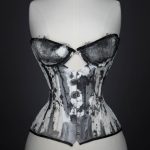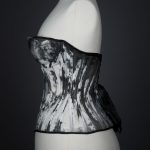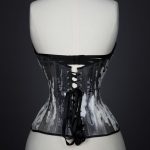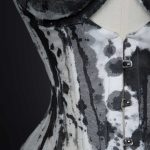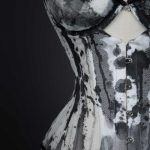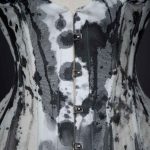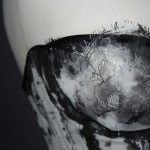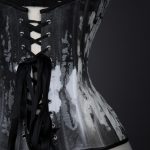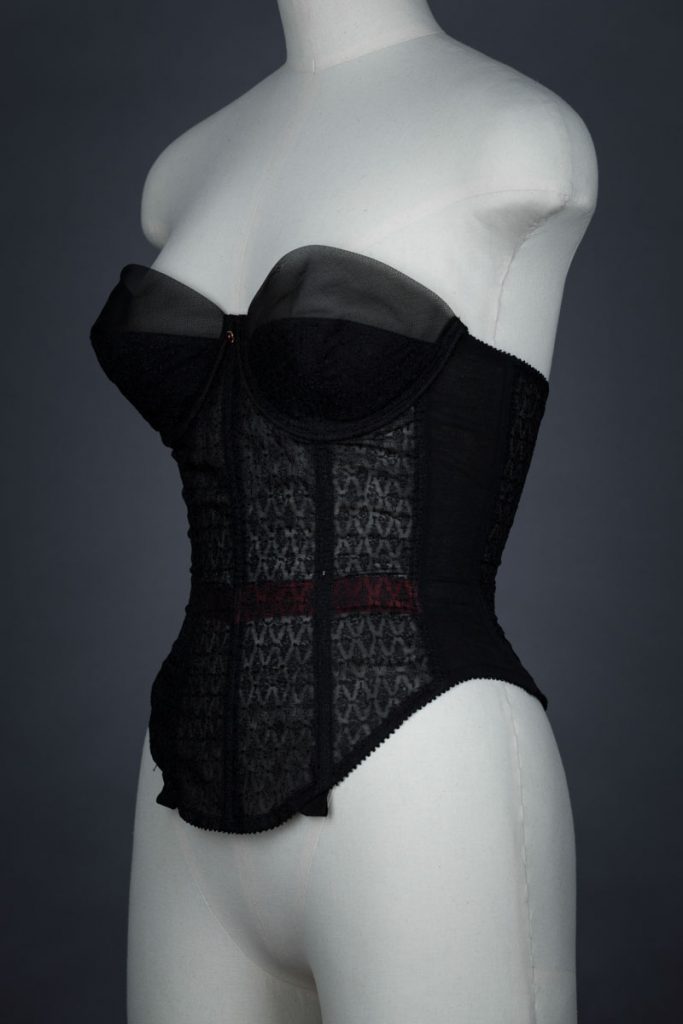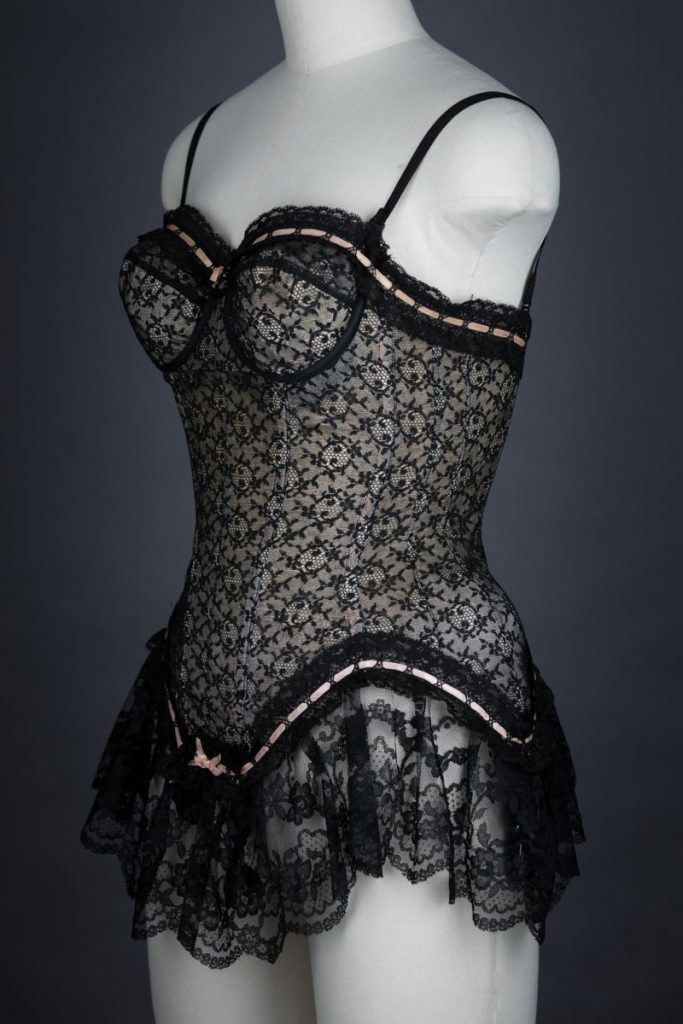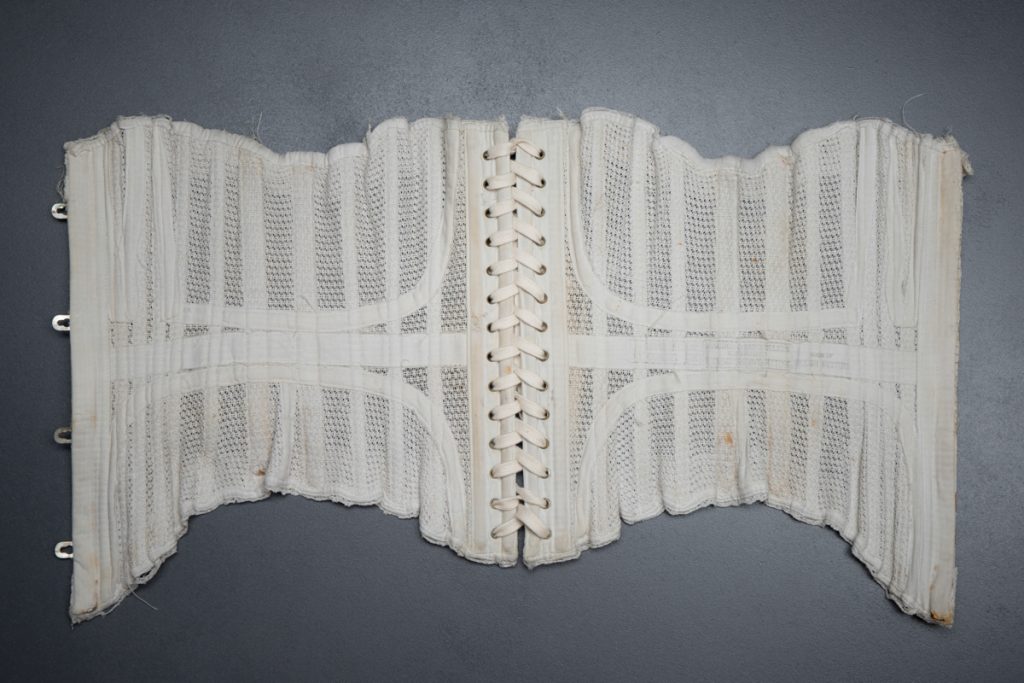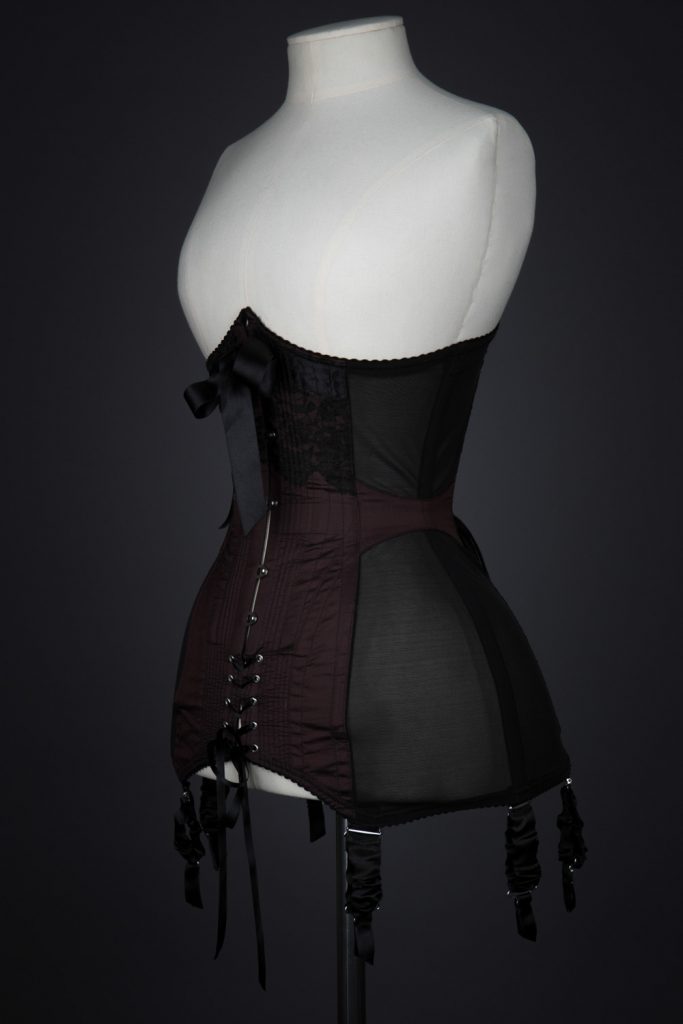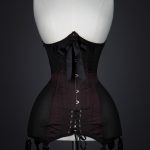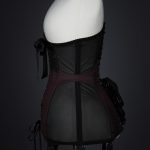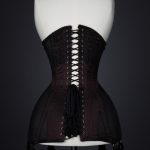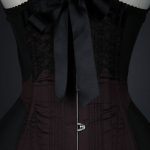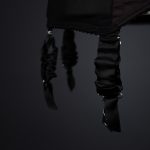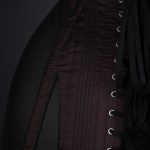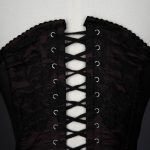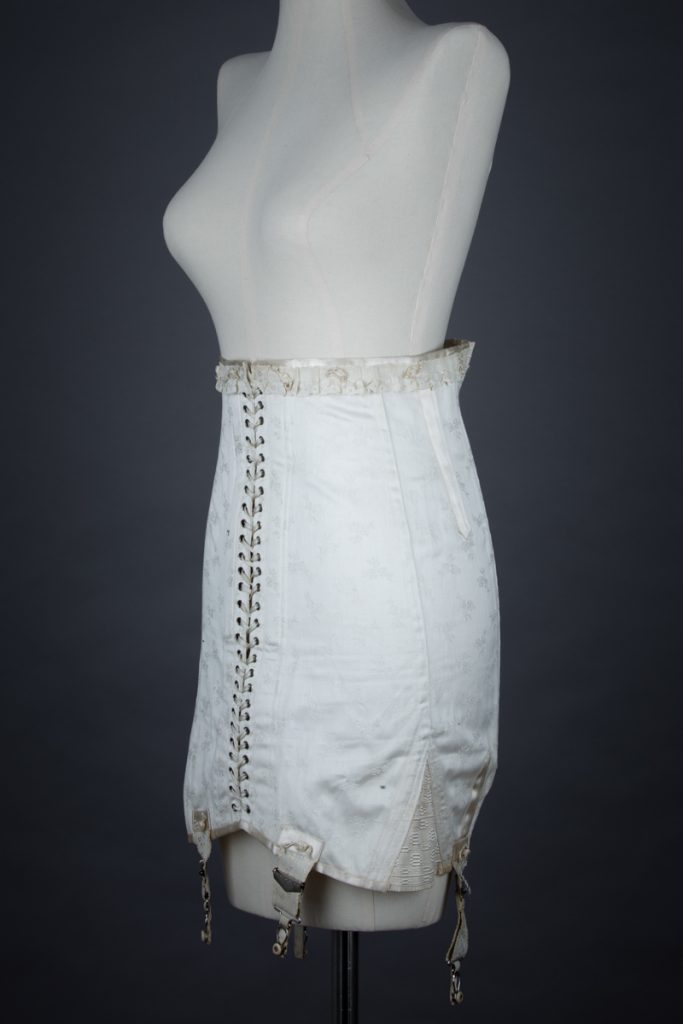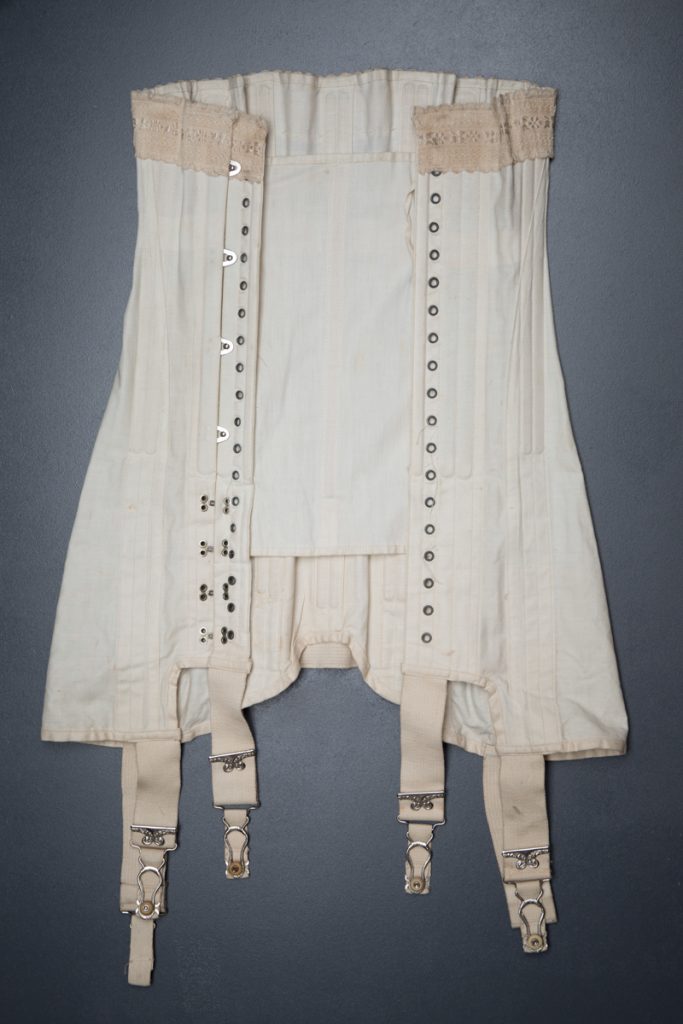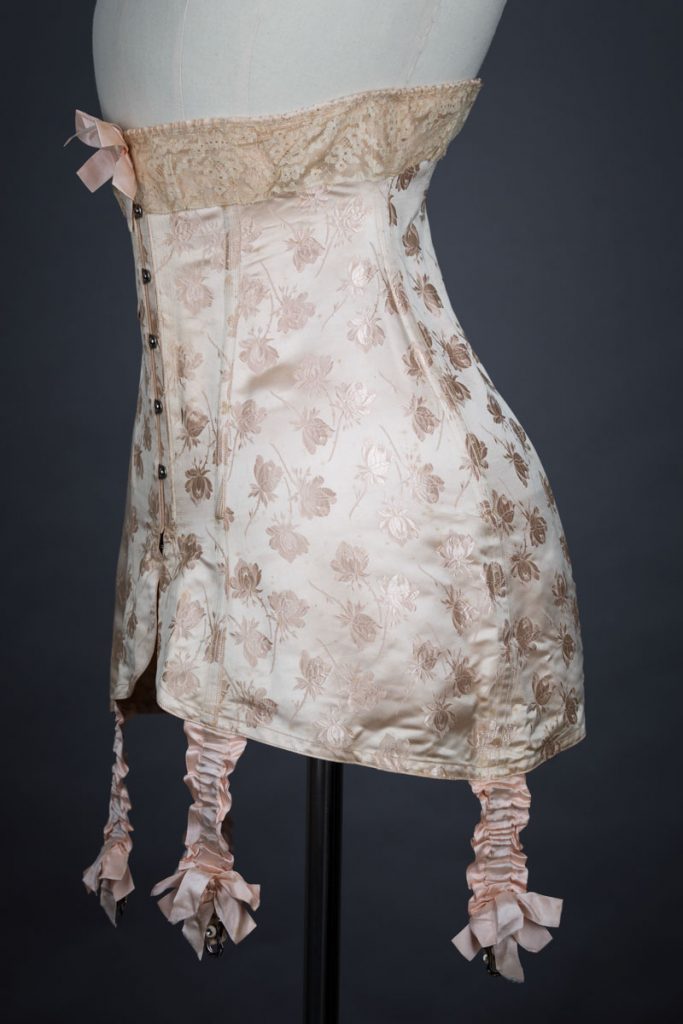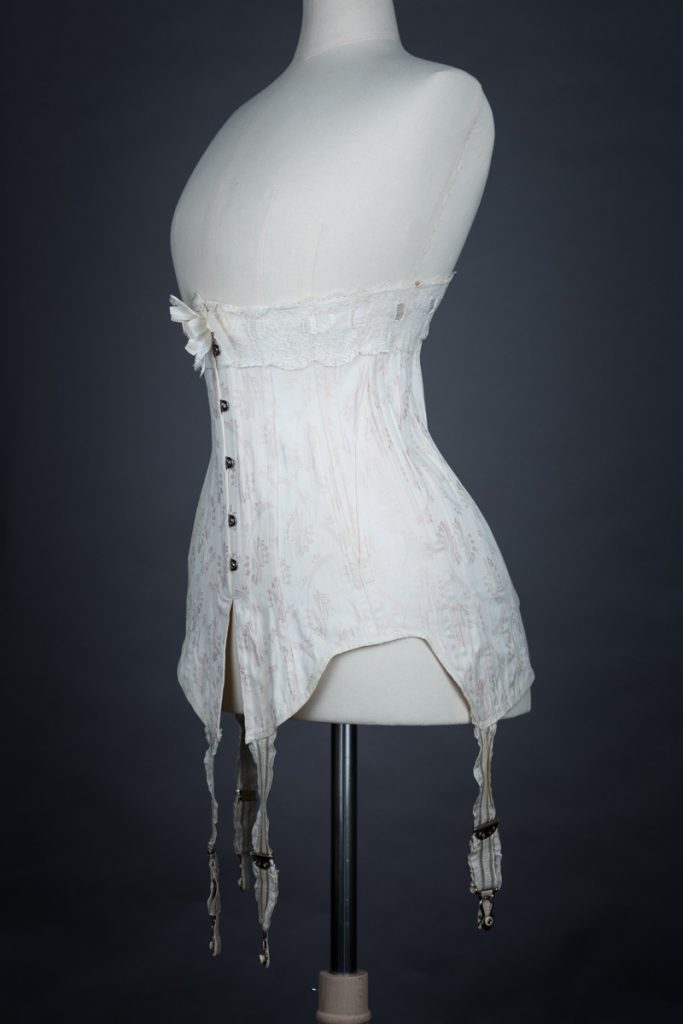One of the largest trends in 21st century corset-making to date is the use of mesh fabrics. These sheer-yet-strong fabrications seem to capture the fascination of both makers and wearers. These lightweight pieces are often designed as “true” lingerie – neither outerwear, nor basic foundation, but indulgent and sensual. The fabrics used to create this effect vary: on one end of the spectrum, basketwoven, non-stretch nylon-mesh; on the other, elastane-blended stretch powermesh; in the middle, supple cotton bobbinet.
Chapter 3: Mesh Corsets
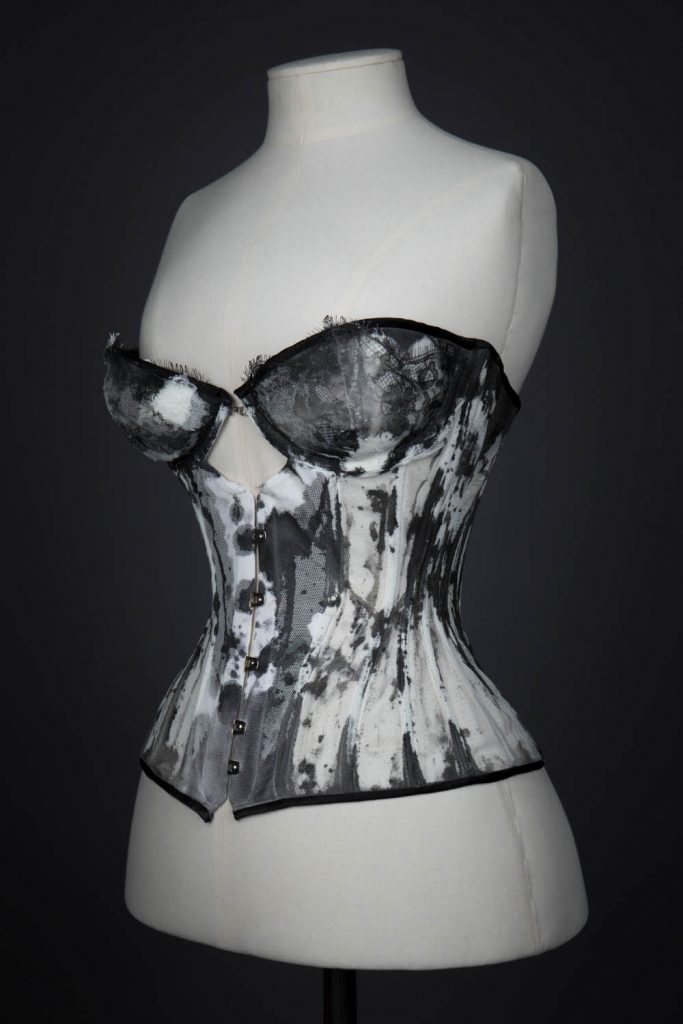
'Ink' Bobbinet Cupped Corset By Karolina Laskowska
Date: 2015
Origin: United Kingdom
Fabric: Cotton bobbinet tulle, nylon tulle, French leavers lace, PU foam.
Brand: Karolina Laskowska
The ‘Ink’ corset is a hybrid of contemporary lingerie techniques with antique-influenced corsetry. Foam-lined and underwired cups incorporate adjustable elastic bra wings which close with hook and eye tape. The body of the corset is made of cotton bobbinet tulle with bone channels created from cotton twill tape. 5mm spiral steel boning vertically support the corset, with flat steel bones at the centre back framing silver toned eyelets. An original c. 1900s busk is used for the front closure. The centre front and back panels have layers of nylon tulle as re-enforcement. The completed garment was hand-painted with drawing ink, giving a textured and chaotic feel to an otherwise carefully considered garment.
Modern corsetieres are no longer constrained purely by function: their corsets can be anything from lingerie, to eveningwear, to pure art. To my eyes there’s no other garment that offers such a versatile canvas for creativity.
Karolina Laskowska, 2018
Ironically, though the shapewear of the 1950s utilized many corsetry techniques and materials, it isn’t usually considered within the umbrella due to its frequent utilization of stretch materials and lack of lacing. Only in recent years has a trend toward merging 20th century shapewear with Victorian corsetmaking appeared, and it continues to increase in popularity. This is evident in cupped styles, the increasing popularity of bobbinet as a foundation fabric, and in the recent use of stretch fabrics in waist-reducing, lace-up corsets such as Sian Hoffman’s signature longline corset girdle. The Underpinnings Museum has already proven itself a rich source of inspiration following its showcase at the 2017 Oxford Conference of Corsetry. Its impact is likely to be increasingly visible in the decade to come.
Lace flounce & Ribbon Slot Corselet By Simone Pérèle
Date: c. late 1950s
Origin: France
Fabric: Nylon lace
Brand: Simone Pérèle
Simone Pérèle was a designer that believed women shouldn’t have to sacrifice their comfort for the sake of elegance and fashion, and championed the use of lightweight materials for use in foundationwear. This style is not dissimilar to the Warner’s Merry Widow, using a combination of rigid nylon and lace, elastic nylon net and spiral steel bones to offer dramatic shaping to the body without the use of traditional heavy construction of corsetry.
Longline 'Cinch-Bra' Merry Widow By Warner
In the late nineteenth century, New York physician Dr Lucien Warner gave up his practice to begin a new career lecturing on women’s health issues, including the effects of the corset. In 1873, he designed a corset that provided the desired fashionable shape along with increased flexibility. The following year, Lucien Warner and his brother founded Warner Brothers Corset Manufacturers. After buying Mary Phelps Jacob’s brassiere patent in 1915, Warner’s went on to introduce lettered cup sizing in the 1930s and released its first line of extremely successful ‘Merry Widow’ foundation garments in 1952.
Named after but not featured in the Lana Turner movie The Merry Widow, Warner’s expanded their collection and updated the styles throughout the 1950s. All Warner’s ‘Merry Widow’ corselets and cinch-bras were promoted for their ability to create a fashionable hourglass silhouette. Travel was popular in the 1950s and synthetics were not only easy to look after but also lightweight and so wouldn’t take up much of the newly introduced baggage allowance on flights. The Warner’s ‘Merry Widow’ is a good example of an almost Victorian style of corsetry made using the lightweight materials of the 1950s. Usually constructed from embroidered nylon marquisette or lace and lined with plain nylon marquisette, with nine spiral steel bones for structure and shaping, these garments weigh a fraction of a similar garment made from cotton coutil.
'Langdon Bathceller's Genuine Thomson's Glove Fitting' Corset, 'Made Of English Netting'
Date: c. 1902
Origin: United States
Fabric: Cotton bobbinet tulle, ‘English netting’
Brand: Langdon Batcheller’s Genuine Thomson’s Glove Fitting
The incredibly lightweight construction of this corset suggests that it was intended for wear in hot or humid climates. The single layer of ‘English net’ (a cotton tulle) was strong enough to support and shape the body, whilst offering much more breathability and flexibility of movement than a standard corset.
The pattern for this corset is rather unusual, as it relies on three main horizontal panels with an additional bust dart for shaping. Seams are taped over with a cotton twill tape for re-enforcement, with a cotton twill waist tape running through the centre line of the garment.
The corset is boned entirely with steel bones, ranging in thickness from 3mm to 10mm. The bones all appear to be flat steel, and although quite flexible, don’t have the same range of movement as spiral steel wires. This is evident through the number of bones that have snapped and penetrated the exterior fabric.
The ‘Thomson’s Glove Fitting’ range of corsets was heavily advertised, offering an exceptional fit, supposedly akin to custom made gloves. This particular style was promoted for its ‘traverse seams running around the body’, which supposedly ‘evades all strain’ and offers a ‘perfect fit for all figures’.
The Met Museum has a number of Langdon Batcheller Co. corsets within its collections. This corset also appears to have a very similar construction to our example of this garment.
Silk & Powernet Corset Girdle By Sian Hoffman
Date: 2011
Origin: United Kingdom
Fabric: Silk, lace and powernet
Brand: Sian Hoffman
This longline girdle fuses the techniques of 1950s foundationwear with contemporary materials and silhouette. The mix of stretch powernet panels and gussets with elastic trims, paired with rigid silk gives a dramatic nipped waistline whilst maintaining a level of flexibility and comfort that most traditional girdles lack.
The girdle fastens with a busk closure and a small panel of lacing at the centre front. It is embellished with a mix of cording and antique lace overlay, with a decorative satin bow at the centre front. There are six garter straps covered in ruched silk. It is structured with a mix of spiral and flat steel bones throughout the garment, to maintain vertical tension.
This garment was a custom commission for an individual client in 2011, based on the designer’s popular corsetted girdle design. The piece originally had a detachable satin ribbon frame bra attachment which has sadly been lost.
Sian Hoffman has been creating luxury, innovative corsetry since 2005, fusing contemporary and fetish inspired design with traditional corsetry techniques. Each garment is hand made by the designer herself, from the inception of unique patterns for each client to hand finished embellishment. Hoffman’s designs have three aims: to modify the body and create a dramatic silhouette, to inspire sensual empowerment and confidence, and to enhance dominance and a submissive effect on others. The brand’s designs blur the boundaries between fashion and fetishism, and have become a favourite corset brand of numerous celebrities and high-fashion print publications.
The 1910s saw the extension of the corset into a longline silhouette that eventually evolved into the girdle. Early stretch gusset construction can be seen as far back as the late teens. The creation of stable stretch fibres in the late 1920s revolutionised foundationwear, offering far more flexible and comfortable fits.
The Underpinnings Museum relies on your generous support to continue its work. If you’ve enjoyed visiting the website, please consider donating to The Underpinnings Museum or purchasing some merchandise. All funds are invested directly back into the project to bring you more free access underwear history.
